

In our orchards we are now at the stage where fruit size has passed the point of chemical thinning and any thinning will be done by hand.
Growers assess crop load by variety before making thinning decisions. For example Braeburn can grow too large for the required specification if over thinned (or carrying a lighter crop load) so it's best to leave fruit numbers and maintain a natural control over fruit size. Gala tends to overset and if not thinned early can in some seasons struggle for 'optimum size' at harvest.
Cell division which takes place for circa 6 weeks from fruit set. End of June? This year weather has been perfect for cell division and this should naturally assist fruit size, but very importantly enhance fruit texture and storage capability!
Most growers try to thin early 'where required' leaving any future thinning closer to harvest where a 'quality hand thinning' operation enables ease of picking at harvest with only any obvious defective apples dropped on the ground. e.g. rots from bird pecks, visibly diseased fruit etc.
Below: left. Gala apples in need of thinning and right. after an initial thin

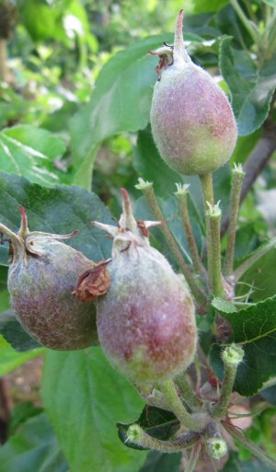
Before continuing the current tasks in June, Two video's of Pear root pruning and Pulverising pruning's both borrowed from BAPL Orchard Watch where growers upload home videos from their orchards.
Click on: Root pruning Conference Pears
Click on: How an orchard pulveriser works
Click on: BAPL Orchard Watch
-------------------------------------------------------------------------------------------------------------------------------------------------------
Routine tasks during June will centre on Pest & Disease control and one of the more enjoyable tasks 'Mowing the alleyways
Click on: Innovative orchard grass mowing
This mower casts the cut grass onto the strip under the trees adding nutrients via a mulch.
Monitoring and dealing with pests is critical at this time of the year
Below: Left. Codling Moth Trap with a rather extreme catch of moths and right. Codling Moth on apple leaf
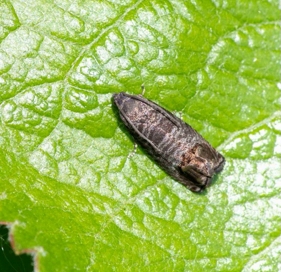

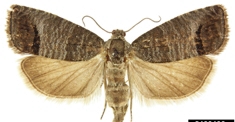
Insecticide sprays must be timely, based on traps tracking moth flights, and the traps need to be set well in advance. A diversity of insecticides should be chosen so that pests don't evolve resistance to an over-used spray. And even non-chemical control techniques, such as pheromone disruption, require good planning.
Below: left. Codling maggot entering an apple and right. Damage caused by Codling Maggot inside apple

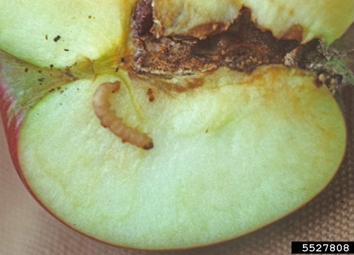
Combatting Pear Sucker with Predators
Pear Sucker is one of the most challenging pests affecting pear production; the beneficial predators - anthocorids and earwigs and their natural habitats; Willow, Hawthorn, Hazel and Nettle. Maintaining habitats (networks of hedgerows) and 'avoiding broad spectrum insecticides' is vital to developing beneficial predators.
Below: This tree (top) has serious infestation from Pear Sucker with severe leaf curl and black sooty blotch
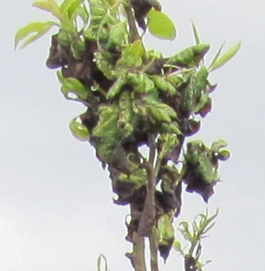 Cacopsylla pyricola, commonly known as the pear sucker, is a true bug in the family Psyllidae and is a pest of pear trees (Pyrus). It originated in Europe
Cacopsylla pyricola, commonly known as the pear sucker, is a true bug in the family Psyllidae and is a pest of pear trees (Pyrus). It originated in Europe
Antholine nemoralis
Anthocoris nemoralis is the more abundant and efficient controlling factor of Cacopsylla pyri, the 'Pear psylla,' in Europe. It is a polyphagous predator that can be found in many crops or wild plants other than pear orchards.
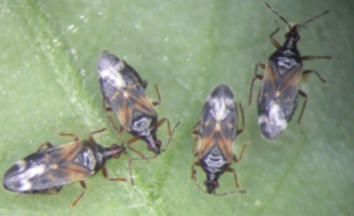
Adult C. pyricola overwinter on the bark or twigs of a pear tree, or on other trees and shrubs near pear orchards. In the spring, the female lays eggs on twigs and expanding shoots of host trees, attaching them by means of short stalks on their ventral surfaces. On hatching, the nymphs feed on the buds and flowers of the host tree, inserting their mouthparts and sucking out the sap. Later in the year, the eggs are laid beside the veins on the upper surface of leaves. The nymphs pass through five instars before becoming adult in a few weeks. There may be up to six generations each year and numbers of insects can build up fast. The nymphs produce copious honeydew which attracts ants, flies, bees and other insects.
Below: Left. Anthocorid is an important predator for right. Pear Sucker
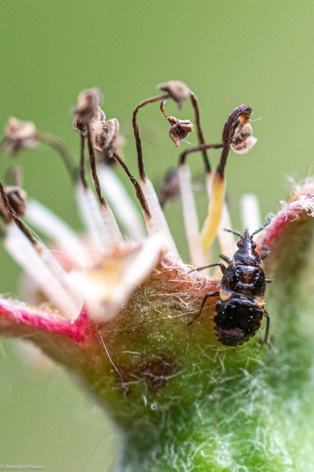
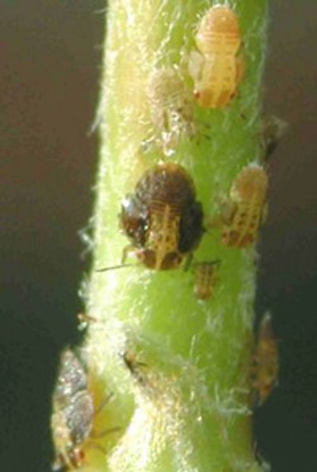
Below: Rosy Apple Aphid damage on young apple shoots
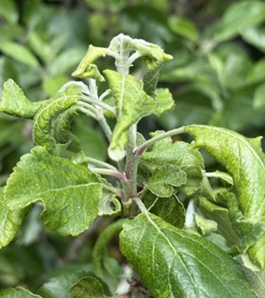 The Rosy Apple Aphid in my garden apple trees is still present, but declining. Commercial growers are benefiting from predation from Hoverfly larvae and Earwigs.
The Rosy Apple Aphid in my garden apple trees is still present, but declining. Commercial growers are benefiting from predation from Hoverfly larvae and Earwigs.
Scab, Mildew and Canker are always present, whatever the weather (after the long warm and dry weather it is difficult to believe any scab existed, but a soon as wet weather returned, scab was easily found! ) The humidity guarantees Mildew increasing (it's always hiding somewhere )
![]() That is all for this week
That is all for this week
Take care
The English Apple Man